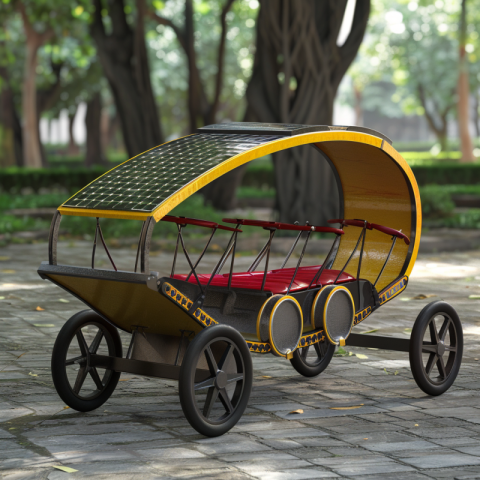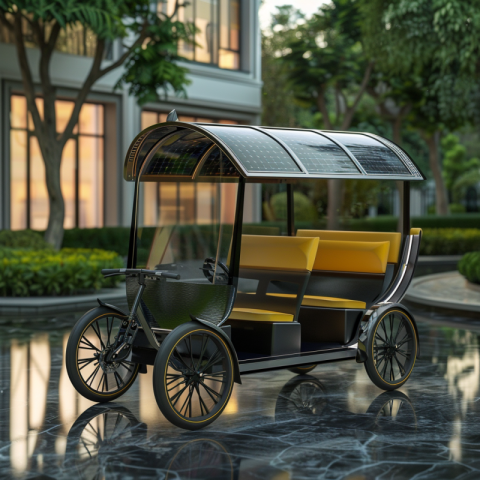



The Auto Rickshaw: An Essential Element of Global Transportation
The auto rickshaw, also known as a tuk-tuk, three-wheeler, or auto, is a ubiquitous mode of transportation in many parts of the world, particularly in South Asia, Southeast Asia, Africa, and parts of Latin America. These three-wheeled vehicles are essentially a motorized version of the traditional pulled rickshaw or cycle rickshaw. They play a vital role in urban and suburban transit, offering an affordable and readily available means of getting around, often filling gaps in public transportation networks.
Types of Auto Rickshaws:
Auto rickshaws can be broadly categorized based on their design, fuel type, and intended use:
- Passenger Auto Rickshaws: This is the most common type, designed to carry passengers. They typically have a driver's seat in the front and a bench seat for two or three passengers in the rear.
- Open-Sided: These have open sides with a canopy roof, offering natural ventilation.
- Enclosed: These have enclosed sides with doors, providing more protection from the elements.
- Cargo Auto Rickshaws: These are modified to carry goods instead of passengers. They may have a flatbed or a closed cargo compartment in the rear.
- Electric Auto Rickshaws (E-Rickshaws): These are becoming increasingly popular as a more environmentally friendly alternative to traditional gasoline or CNG-powered rickshaws. They are powered by electric motors and batteries.
- Compressed Natural Gas (CNG) Auto Rickshaws: These are popular in areas with CNG infrastructure, considered cleaner than gasoline but produce less greenhouse gases compared to petrol.
- Petrol/Gasoline Auto Rickshaws: The traditional type using petrol internal combustion engines.
- Diesel Auto Rickshaws: Are also used but are normally for carrying goods rather than passengers.
Uses of Auto Rickshaws:
Auto rickshaws serve a variety of transportation needs:
- Public Transportation: In many cities, they operate as shared taxis, following fixed or flexible routes. They provide a crucial link between residential areas, commercial centers, and public transportation hubs.
- Private Hire: Passengers can hail auto rickshaws on the street or hire them through apps for point-to-point transportation. They offer a more convenient and often faster alternative to buses or other forms of public transport, especially in congested areas.
- Goods Transportation: Cargo auto rickshaws are used to transport a wide range of goods, from small packages to larger items like furniture and construction materials. They are particularly useful for navigating narrow streets and making deliveries in densely populated areas.
- Tourism: In some tourist destinations, auto rickshaws are used to provide tours and sightseeing experiences.
Engine and Fuel Types:
Auto rickshaws are powered by a variety of engine and fuel types:
- Two-Stroke Engines: These were once common but are being phased out due to their high emissions.
- Four-Stroke Engines: These are more fuel-efficient and produce fewer emissions than two-stroke engines. They are the most common engine type in modern auto rickshaws.
- CNG Engines: These engines run on compressed natural gas, a cleaner-burning fuel than gasoline.
- Electric Motors: Powered by batteries, these are becoming increasingly popular in e-rickshaws.
- LPG Engines: These engines run on Liquefied petroleum gas.
Cultural Significance:
In many parts of the world, auto rickshaws are more than just a mode of transportation; they are a cultural icon. They are often brightly decorated and personalized by their owners, reflecting local art and traditions. They are also a significant source of employment for drivers, providing a livelihood for millions of people.
Economic Impact:
Auto rickshaws play a significant role in the economies of many developing countries. They provide affordable transportation for the masses, support small businesses through goods transportation, and create employment opportunities. The auto rickshaw industry also encompasses manufacturing, maintenance, and repair services, further contributing to economic activity.
Environmental Concerns and Sustainability:
Traditional auto rickshaws, particularly those with two-stroke engines, are significant contributors to air pollution in urban areas. However, there is a growing movement towards more sustainable options:
- Electric Rickshaws: E-rickshaws produce zero tailpipe emissions, making them a much cleaner alternative. Governments and organizations are promoting their adoption through subsidies and other incentives.
- CNG Rickshaws: CNG is a cleaner-burning fuel than gasoline, resulting in lower emissions of harmful pollutants.
- Improved Engine Technology: Four-stroke engines are more fuel-efficient and less polluting than two-stroke engines.
Challenges and Future Trends:
The auto rickshaw industry faces several challenges:
- Regulation and Safety: Ensuring the safety of passengers and drivers through proper regulation and enforcement.
- Competition: Competition from other modes of transportation, such as ride-hailing services and expanding public transit networks.
- Environmental Concerns: Addressing the pollution caused by traditional auto rickshaws.
- Technological Advancements: Adapting to new technologies, such as electric and autonomous vehicles.
Despite these challenges, the auto rickshaw is likely to remain an important part of the transportation landscape for the foreseeable future. The ongoing shift towards electric and other cleaner technologies, coupled with innovative business models and supportive government policies, will shape the evolution of the auto rickshaw in the years to come.
Conclusion:
The auto rickshaw is a versatile and essential mode of transportation in many parts of the world. Its affordability, accessibility, and adaptability have made it a popular choice for passengers and businesses alike. While challenges remain regarding environmental impact and safety, the industry is evolving towards more sustainable and technologically advanced solutions. The auto rickshaw's enduring presence and cultural significance underscore its importance in the global transportation ecosystem, and its future will undoubtedly be shaped by the ongoing trends of urbanization, technological innovation, and the growing demand for cleaner and more efficient modes of transport.
auto rickshaw, tuk-tuk, three-wheeler, auto, types of auto rickshaws, auto rickshaw uses, auto rickshaw transportation, e-rickshaw, electric rickshaw, CNG auto rickshaw, auto rickshaw in India, auto rickshaw in Asia, auto rickshaw driver, auto rickshaw fare, auto rickshaw price, auto rickshaw design, auto rickshaw engine, auto rickshaw parts, auto rickshaw manufacturing, auto rickshaw regulations, auto rickshaw safety, auto rickshaw pollution, auto rickshaw history, auto rickshaw culture, auto rickshaw vs taxi, auto rickshaw vs bus, auto rickshaw hire, auto rickshaw app, auto rickshaw service, auto rickshaw business, auto rickshaw for sale, used auto rickshaw, auto rickshaw modifications, auto rickshaw accessories, auto rickshaw maintenance, auto rickshaw repair, auto rickshaw license, auto rickshaw permit, auto rickshaw insurance, auto rickshaw financing, auto rickshaw loan, auto rickshaw subsidy, government schemes for auto rickshaws, future of auto rickshaws, auto rickshaw technology, auto rickshaw innovation, electric vehicle, sustainable transportation, urban transportation, public transportation, last-mile connectivity, shared mobility, micro-mobility, developing countries transportation, emerging markets transportation, informal transportation, three wheeler taxi, motor taxi, motorized rickshaw, passenger three wheeler, cargo three wheeler, three wheeler vehicle, three wheeler auto, three wheeler price, three wheeler license, three wheeler driver, three wheeler service, three wheeler parts, three wheeler business, three wheeler for sale, three wheeler modifications, three wheeler accessories, three wheeler maintenance, three wheeler repair, three wheeler insurance, three wheeler financing.

